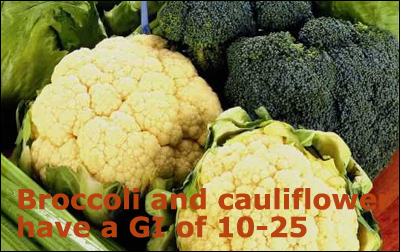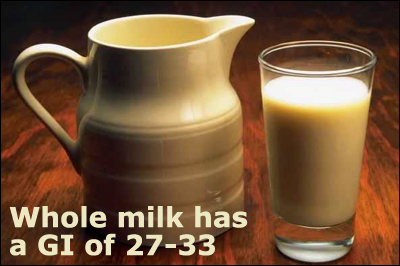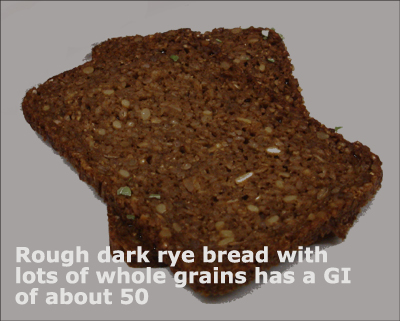A low glycemic food list is a collection of foods that are rated as being low on the glycemic index chart – a handy numeric rating system that indicates how different types of food affect your blood sugar levels.
Based on a scale of 0 to 100-plus, low glycemic foods generally has a rating of 50-55 or less (going above 55, you enter into the medium zone – and above 70 you are in the red hot high glycemic index zone).
The one single requirement for foods getting a number above 0 in the glycemic index system is to contain carbohydrates (which transforms into glucose when digested).
Therefore you will not find meat (or most meats) or eggs in the system as they don’t contain any carbohydrates.
So what we’re looking at and measuring the effect of are fruits, grains, vegetables, sugars and dairy products.
Keeping Your Blood Sugar Consistent Is the Purpose of a Low Glycemic Diet
Following a low glycemic diet is a natural way to control your blood sugar level, making sure it doesn’t spike suddenly and thus preventing the excess insulin production which is the natural result of that.
You see, you don’t want too much insulin because it pushes your blood sugar too far down resulting in a ‘sugar low’ making you feel tired and craving sugar.
The low glycemic food diet is type of diet particularly helpful to people who are looking to lose weight or manage type two diabetes, as well as a range of other conditions.
Understanding the glycemic index chart and what constitutes a low glycemic diet can be a complex affair, with a lot of information to digest and plenty of jargon thrown in for good measure.
However, once you understand the different terminology, as well as what you can and cannot include in a diet such as this, you will find creating your own low glycemic food list easy enough.
The Low Glycemic Food List
Fruits (Low to Moderately High GI)
– Fresh Fruits Have a Lower GI, More Processed Means Higher Glycemic Index
 Many people tend to assume that all fruits make a fairly safe addition to any type of diet plan.
Many people tend to assume that all fruits make a fairly safe addition to any type of diet plan.
However, this is not the case at all, especially when it comes to a low glycemic diet in particular says a Harvard Health School Publication.
The publication goes on to point out that people should remember that fruit comes in a variety of forms, including fresh, dried, canned and juiced.
Each different type of fruit has its own rating on the glycemic index chart. For example, orange juice has a glycemic index rating of 53, whereas fresh orange pieces score a much lower 43 – making this type a more worthwhile addition to your low glycemic food list.
Other low-scoring fruits include banana, fresh and dried apricots, pears, apples and grapefruit.
Vegetables (Generally Quite Low GI)
– Greens Are Great
 Fortunately, most types of vegetables have a relatively low glycemic index score with only some starchy vegetables such as corn, beets and white potatoes scoring above 50.
Fortunately, most types of vegetables have a relatively low glycemic index score with only some starchy vegetables such as corn, beets and white potatoes scoring above 50.
Carrots are just below the recommended score at 48, but you should include them on your list as this is still considered low.
Vegetables with a particularly low glycemic index rating include spinach, broccoli, peppers, onions and cabbages should definitely make your low glycemic food list.
Dairy Products (Relatively Low GI)
 According to the University of Wisconsin, all types of milk products have a low glycemic index rating.
According to the University of Wisconsin, all types of milk products have a low glycemic index rating.
This includes flavored milk and yogurts, which is a blessing for those people who have something of a sweet tooth.
The University goes on to say that semi-skimmed milk products score the lowest on the glycemic index chart, with the average chocolate milk coming in at around 33.
Grains (From Low to Very High GI)
– General Rule: The ‘Whiter’, the Higher the GI
 This particular group of food requires the most vigilance when making additions to your low glycemic food list, as many products have a high index scoring.
This particular group of food requires the most vigilance when making additions to your low glycemic food list, as many products have a high index scoring.
The worst offenders are cooked or ready-to-eat cereals and other highly processed foods, with scores hitting well above 70 for many things.
The Harvard Health School Publication recommends adding wholegrain bread, converted rice, bulger wheat and whole-wheat spaghetti to your list from this particular food list, as these tend to be the products with the lowest score.
Nuts and Legumes (Low GI)
– Plus They Have a High Healthy Protein Content
 Soy beans, split peas, dried beans and lentils are all extremely low glycemic foods, with scores not moving above 14 on the glycemic index chart.
Soy beans, split peas, dried beans and lentils are all extremely low glycemic foods, with scores not moving above 14 on the glycemic index chart.
Kidney beans, garbanzo beans and black beans will also make good additions. You can even add prepared baked beans to your low glycemic food list, as most varieties score around 47 on the index.
According to the American Diabetes Association, most products available in supermarkets and grocery stores will have some indication of the glycemic rating on the packaging.
In fact, in 2009, a special GI symbol was unveiled to help people recognise which foods scored low on the glycemic index chart.
Factors that Affect the Glycemic Index Rating of Food
– Texture, Size, Ripeness and Viscosity (Food Thickness)
For example, while bananas are considered a good addition to any low glycemic food list, a ripe banana has an average glycemic score of 50, where as an unripe banana scores around 33.
Fructose (a type of carbohydrate found commonly in fruit), soluble fiber, protein, fat and lactose (the carbohydrate present in milk) are also known to lower the glycemic response in certain foods.
Acidic foods, such as certain fruits and vinegar, slow down the rate of digestion by decreasing the time it takes the stomach to empty – this also helps reduce the glycemic index rating.
Food that is easily absorbed by the body, usually because it has been broken down into particles or small pieces during the cooking process will have a higher glycemic index rating than food that has been cooked and then allowed to cool down.
It is therefore advisable that when you are considering which foods to add to your list, you should also consider portion size, cooking method and whether the product is fresh.
The Glycemic Load Takes the Amount of Carbs into Account
When learning more about the low glycemic diet, you will probably come across the term glycemic load.
This refers to how much carbohydrate is in a certain food and how much each gram of it will affect an individual’s blood sugar level.
The glycemic load is most commonly reached by multiplying the food’s glycemic index rating by the number of carbs in it.
Confused yet?
You don’t have to be, as most food products will have displayed the glycemic load in the nutritional information on the back of the packaging. This information is usually with the rating that the particular food has on the glycemic index chart. (If you want a simple formula to calculate the glycemic load yourself – you can go to this page.)
There is currently no scientific evidence to suggest that following a diet of food containing a low glycemic load will result in significant weight loss. However, the American Diabetes Association believes this type of diet can help effectively manage the symptoms associated with type 2 diabetes.
Eating Low Glycemic Foods Can Have a Positive Effect on:
– Weight Loss, Diabetes, Acne, PCOS as Well as Your Athletic Performance
Weight Loss – Keeps Your Appetite in Tighter Reins
As well as controlling blood sugars, following a low glycemic diet can help control your appetite, according to the University of Wisconsin.
Scientific studies that have compared the results of diets involving both high and low glycemic index foods seem to indicate that neither type of diet resulted in significant weight loss.
However, some medical experts believe that using the glycemic index is a good way to plan a diet but that the nutritional quality of the person’s diet and portion sizes should also be a major factor for those looking to lose weight.
Diabetes – Controlling the Blood Sugar Level
According to a study published in the acclaimed Journal of the American Medical Association, following a low glycemic diet for a period of around six months helped people suffering from type 2 diabetes to control their blood sugar.
Following an organized low glycemic food list or a medically-prepared diet not only helped certain individuals control their blood sugar naturally, it also significantly reduced their chances of suffering from serious heart conditions.
According to the American Diabetes Association, cases of type 2 diabetes are almost double what they were twenty years ago and the Association blames this almost entirely on people’s diets.
What once were considered staple items in a person’s diet, things such as beans, whole grains, nuts and pasta, are no longer featured.
And instead, people are eating higher portions of high-fat, processed foods that all score high on the glycemic index chart.
The Association recommends diabetes sufferers compile a low glycemic food list, as well as educate themselves on other factors that affect the glycemic index score.
Understanding what counts as low glycemic vegetables, low glycemic bread and overall low glycemic carbs is an important part of changing their diet for the better.
Acne
Although more medical studies are needed to understand the effects a high glycemic diet has on acne sufferers, preliminary studies appear to suggest that foods with a high glycemic load can exacerbate cases of severe acne and other skin conditions.
A study covered by the University of Wisconsin and originally published in the American Journal of Clinical Nutrition, indicated that acne sufferers who followed a strict low glycemic diet saw the appearance of their acne lesions reduce over a period of twelve weeks.
Poly Cystic Ovary Syndrome (PCOS)
As a sufferer of Poly cystic Ovary Syndrome myself, I was aware of the claims that a low glycemic diet could reduce the symptoms of the condition.
In fact, this had been my main motivation to create a low glycemic food list in the first place.
According to medical experts, the symptoms of Poly cystic Ovary Syndrome are better controlled if an individual follows a diet consisting of food that rates low on the glycemic index chart.
Again, as in diabetes sufferers, this is said to be connected to insulin and the fact a low glycemic diet can reduce the amount of insulin released by the body.
However, there is nothing in the way of medical studies to confirm or refute the suggestion eating foods with a low glycemic load will help manage the symptoms of this condition.
Exercise – Increases Endurance
According to the Harvard Health Publication, eating certain foods from a low glycemic food list around two hours before participating in an endurance event, such as cross-country or long distance running and jogging can help improve the individual’s exercise capacity.
According to the Harvard experts, this is because, while the food is no longer in the person’s stomach, it will remain in the small intestine for several hours and it is this that potentially provides extra energy.
Eating food with a high glycemic index chart rating should be eaten after a person has taken part in a serious exercise session or endurance event. This is because high glycemic index foods help to replenish important muscle stores in the first 24 hours after heavy exercise.
Important Things and Facts to Remember …
Phew, that was a lot of information. If you just remember a few of the dots below, you should be well on your way 🙂
- The glycemic index chart rates certain carbohydrates by how quickly they increase glucose levels in an individual’s blood.
- Glycemic load rates certain carbohydrates on the amount of carbs in a particular food, as well as according to the glycemic chart rating.
- Just because certain foods have made it on to your low glycemic food list, doesn’t mean you can eat them in abundance. Portion size and the amount of carbohydrates present are still very important (this is where the glycemic load comes into the picture).
- A diet consisting of legumes, vegetables, certain grains and fruits with lesser servings of things such as high-sugar foods, potatoes and refined goods is recommended.
- Once you have completed your low glycemic food list, it is recommended you run the contents past your doctor especially if you have a condition such as diabetes. Seeking medical advice is always advisable if you are considering making major changes to your diet.
Other Pages on This Site, You Might Want to Visit
Guide to a Low Glycemic Diet: Identifying Foods Low in the Glycemic Index & Ruling out the Sugary High GI Traitors
Find the Values of Different Low Glycemic Index Foods and Learn How to Healthily Follow a Low Carb Diet
Glycemic Index Diet Guidelines: Low Glycemic Recipes and Foods
Exercise Glycemic Control by Following the Low Glycemic Index Diet
A Long Glycemic Index Food List to Keep Your Blood Sugar Levels Balanced
Low Glycemic Index Diet Tips: Simple Guidelines to Avoid the Trickery Pitfalls
A Comprensive Glycemic Index Chart along with a Low Glycemic Food List
Glycemic Index Food Chart Model: Showing You Carbohydrates High and Low in GI
The Healthy Low Glycemic Foods Diet: How to Eat According to the Glycemic Index
Go to the top of this page about the low glycemic food list

